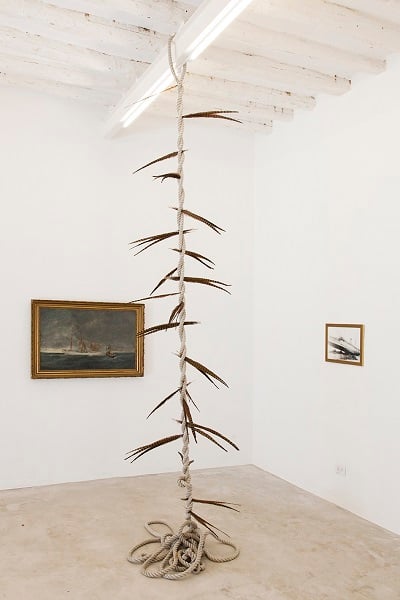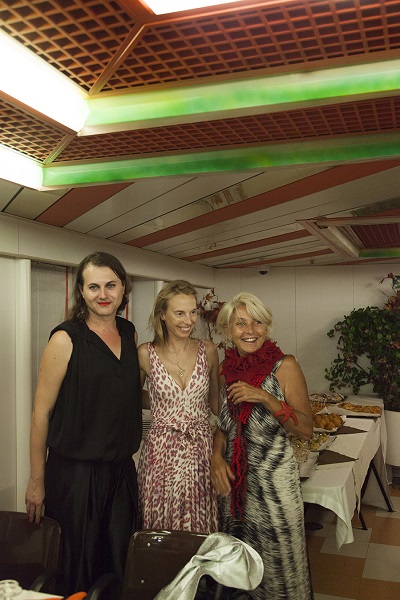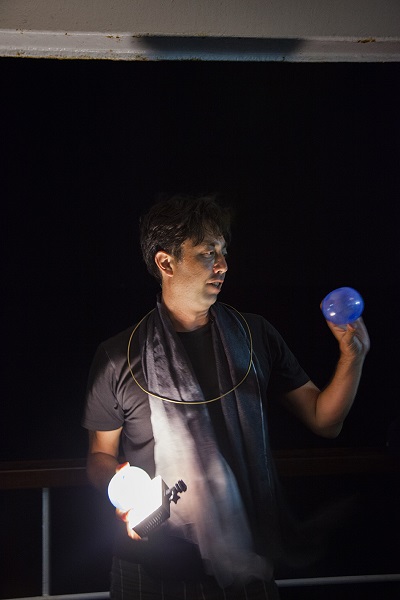Reviews
Camille Henrot Celebrates Alienation on Stromboli for Fiorucci Art Trust’s Extravaganza
The week's program focused on the island's dramatic side.

The week's program focused on the island's dramatic side.

Hili Perlson

Last Monday, after about 14 hours of travel by plane, train, ferry, and an electric three-wheeler—the largest vehicle that fits through the narrow streets of Stromboli—I found myself on the balcony of a middle-aged woman named Barbara, watching the 1975 Peter Weir classic Picnic at Hanging Rock. Barbara, who runs a B&B on the Aeolian Island, is Austrian. She first heard about Stromboli when she was 15, she tells me, and—fascinated by the island’s active volcano—had waited until her 18th birthday to leave everything behind and see it for herself, alone. She never left, and never looked back, she says.
The powerful lure and affect of this island, with its rumbling, ash-spitting mouth that can erupt at any moment, its barren beauty, and scorching heat, set the tone for the week-long program “I Will Go where I don’t Belong,” masterminded by artist Camille Henrot and curator Milovan Farronato for the Fiorucci Art Trust’s annual Volcano Extravaganza, now in its sixth edition.
The title takes its cue from Roberto Rossellini’s 1950 film Stromboli, his first starring Ingrid Bergman (and during which their love affair began), where Bergman’s character, Karin, a World War II refugee, ends up on the harsh island in an attempt to free herself from a displaced persons camp, only to end up imprisoned and isolated there, and scorned by the cruel islanders. Each day of the Extravaganza’s program was governed by a theme relating to the series of events, emotions, and transformations the curators imagined one would experience while going where they don’t belong, such as “Isolation,” “Danger and Eroticism of Distance,” or “Inadequacy,” and took off with “Naufrage”—French for shipwreck.

“I Will Go Where I Don’t Belong”, A Group Exhibition curated by Camille Henrot. Installation view with mural by Camille Henrot and images of “Crossing the Line Ceremonies” from Camille Henrot’s archive. Photo by Giovanna Silva. Courtesy Fiorucci Art Trust, London
At the Fiorucci Art Trust House—which would quickly become nicknamed The Marina Abramović House, after its previous owner, in order to distinguish it from the other houses on the island owned by collector Nicoletta Fiorucci—Henrot curated a show using dozens of dramatic paintings of shipwrecks from her family’s collection, as well as found images, archival articles, and postcards depicting a particular ritual among seafarers: “Crossing the line.” An age-long initiation rite, it marks the very first time a marine or sailor crosses the equator. For the entertainment of the long initiated, as well as out of tradition and superstition, first-timers perform different tasks in drag.
One room in the house doubled as a ticket office for the week’s program of film screenings that took place in the homes of locals, but ones who were not born on the island—which is how I met Barbara. To book film tickets, guests had to sign up with one of two identical twin brothers, Francesco and Alberto. Henrot instructed them to play “bad cop” and “good cop,” and much to the chagrin of those signing up, you never knew who you might end up with. However, the idea of playing “mean” fit with the palpable aloofness on the island; the rough living conditions on Stromboli, which relies on ship deliveries for food and drinking water, seem to appeal to loners and craggier individuals, rumored to be too unfriendly for Abramović to want to keep her house there.

Maria Loboda, Witch’s Ladder, (2014). ©Courtesy of the artist and Maisterravalbuena, Madrid. Photo by Giovanna Silva. Courtesy Fiorucci Art Trust, London
The group show also featured works by artists whom Henrot and Farronato had invited to either stay and create on the island or send works, including Rachel Rose, Mike Nelson, and David Horvitz to name a few. Horvitz hung up mirrors on a dead tree in the house’s garden, which he was told a neighbor had poured poison into in order to gain a better view of the sea. The mirrors reflected the sun back in the direction of the neighbor’s house, to completely block out any view at all. Maria Loboda, who created a “Witch’s Ladder” for the exhibition, complete with Polish pheasant feathers, also had another piece in the form of a sedan chair which mysteriously followed participants around the island, as well as a series of texts on posters that invited inexplicable phenomenon. “Nobody could explain this: That’s the way it was,” read the text sent out to participants on the Extravaganza’s final day.
“It’s not very convivial this year,” an Italian journalist, who’s been to previous editions, commented over wine. Attended by the artists, the many dedicated helping hands working on this challenging event, a handful of journalists, and a number of art world denizens on summer vacation—like Chus Martinez, Carolyn Christov Bakargiev, or Diana Campbell Betancourt—the Extravaganza included evening gatherings with DJ sets by new and former participants like Haroon Mirza and Lucy McKenzie. But the nights were rather tame, as everyone seemed to have a hard time breaking away from the introverted mood set by the program.

Buffalo Head: A Democratic Storytelling Experience, performed by Amira Ghazalla with the participation of Jacob Bromberg, David Horvitz, Maria Loboda and Milovan Farronato. By Camille Henrot. Adapted from Italo Calvino’s folktale of the same name. Photo by Giovanna Silva. Courtesy Fiorucci Art Trust, London
But there were moments of coming together, too, both in terms of participation and collaboration, as well as simply sharing an experience. Amira Ghazalla performed Buffalo Head: A Democratic Storytelling Experience, jointly written by Henrot, Horvitz, Loboda, and Farronato, and edited by poet Jacob Bromberg. Everyone converged in an amphitheater with a breathtaking view, to vote with color coded signs on the possible twists and turns that the tale read out by Ghazalla could take. After finishing with one version, the group unanimously decided to backtrack and explore a different ending. “Did I get the it right?” asked artist Anna Boghiguian mid-way through the performance, perhaps getting tired of having to raise her hand.
Another joint activity was designed by Portuguese artist Joana Escoval, who collaborated with a local pathfinder to create a promenade that led us up the volcano where sculptures in different metals awaited to be discovered along the way.

Milovan Farronato, Camille Henrot and Nicoletta Fiorucci. Photo by Giovanna Silva. Courtesy Fiorucci Art Trust, London
Artist Martin Murphy funnelled the fascination with the island’s hard-edged inhabitants in a two-channel video telling the story of an elderly French women, who had come to the island with her husband years ago, and chose Stromboli over her family when her husband decided to go back. A second film by Murphy cut scenes from Rossellini’s Stromboli with sequences from Disney’s Little Mermaid. He thus invoked another mythical aspect related to the Aeolian Islands, which are believed to be mentioned in Homer’s Odyssey, and be populated by sirens. It is perhaps no coincidence that, much like the “democratic storytelling,” both films have different versions with alternative endings, catering to different audiences.

David Horvitz’s intervention on the night ferry. Photo by Giovanna Silva. Courtesy Fiorucci Art Trust, London
On the last day, titled “Exile,” everyone gathered on the pier at sunset to board a night ferry to Naples. Loboda’s sedan chair appeared again on the dock, and everyone checked in to their night cabins to change for the final night’s dinner. At midnight, we climbed up the stairs to the upper deck for a last performance. Horvitz gave each of us a glass bubble, created with a single breath of air. One by one, we threw the glass spheres into the water, like “bottles without a message,” as Horvitz put it.